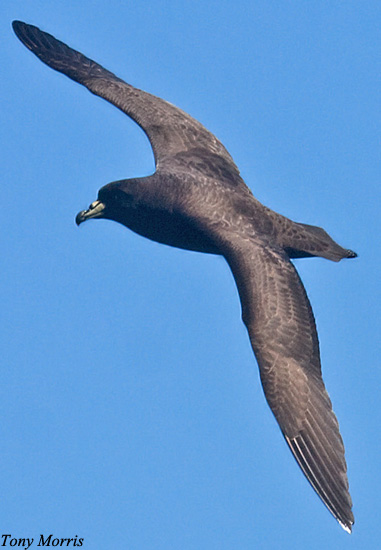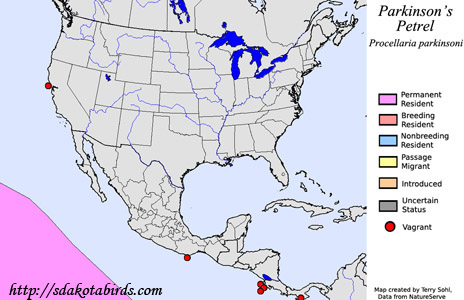| Length: 18 inches | Wingspan: 42-45 inches | Seasonality: Non-resident in South Dakota |
| ID Keys: All black plumage, bluish-yellow bill with black tip | ||
 Parkinson's
Petrel, also known as the "Black Petrel", is a species with an extremely
small breeding range. They are only known to breed on two small
islands of New Zealand, Great Barrier Island and Little Barrier Island.
Outside of the breeding season they disperse widely in tropical and
semi-tropical waters of the Pacific. Non-breeding birds are found as far
east as coastal South America and Central America. In North America,
they are only known as an extremely rare vagrant. A confirmed sighting was
made off Point Reyes National Seashore in California in 2005, and other
unconfirmed reports have also been received off the California coast.
Parkinson's
Petrel, also known as the "Black Petrel", is a species with an extremely
small breeding range. They are only known to breed on two small
islands of New Zealand, Great Barrier Island and Little Barrier Island.
Outside of the breeding season they disperse widely in tropical and
semi-tropical waters of the Pacific. Non-breeding birds are found as far
east as coastal South America and Central America. In North America,
they are only known as an extremely rare vagrant. A confirmed sighting was
made off Point Reyes National Seashore in California in 2005, and other
unconfirmed reports have also been received off the California coast.
Habitat: Found on islands of New Zealand during the breeding season (and formerly were found on the mainland). Nesting habitats are hilly forests. Outside of the breeding season, they are pelagic, ranging widely across the Pacific basin.
Diet: Feeds on fish, crustaceans, and cephalopods.
Behavior: Forages both during the day or the night. They forage while in flight, dipping down to the water's surface to skim prey near the surface, or diving underwater in search of prey.
Nesting: Parkinson's Petrels form monogamous pair bonds, with the male and female returning to a nesting burrow to mate. They then depart for a short time until the female is ready to lay her single egg. Both parents help to incubate the egg and raise the young. The young fledge after about 15 weeks.
Song: Has a variety of chattering calls and squawks, with the vast majority of vocalization occurring around breeding sites.
Migration: Migratory. Breeding continues on the two islands of New Zealand. Outside of the breeding season, both adults and young disperse widely in the Pacific, with many birds moving eastward as far as coastal Ecuador. Young birds are truly pelagic, foraging at sea for at least four years before returning to the breeding islands.
Interactive eBird map: Click here to access an interactive eBird map of Parkinson's Petrel sightings
Similar Species: Similar in general appearance to other dark petrels and shearwaters, such as Sooty Shearwater, Short-tailed Shearwater, the dark morph of the Herald Petrel, White-chinned Petrel, and the Great-winged Petrel.
Conservation Status: The Parkinson's Petrel has declined in population, and is listed as "vulnerable" by the IUCN. They only breed on two small islands and as such, are considered extremely vulnerable to disturbance or potential introduction of predator species. They used to breed on additional islands and on the mainland of New Zealand, but feral cats, rats, and pigs caused local extinctions except on Great Barrier and Little Barrier islands. These introduced species are also present on Great Barrier Island and have impacted breeding, but the colonies persist.
Further Information: 1) BirdLife International - Black Petrel
2) New Zealand Birds Online - Black Petrel
3) Cornell's Neotropical Birds - Parkinson's Petrel
Photo Information: Photo licensed under Creative Commons Attribution NonCommercial 2.0 Generic License - Photo by Tony Morris
| Click below for a higher-resolution map |
 |
| South Dakota Status: Non-resident in South Dakota |
Additional Parkinson's Petrel Photos (coming soon!!)
